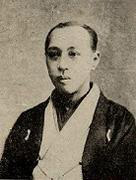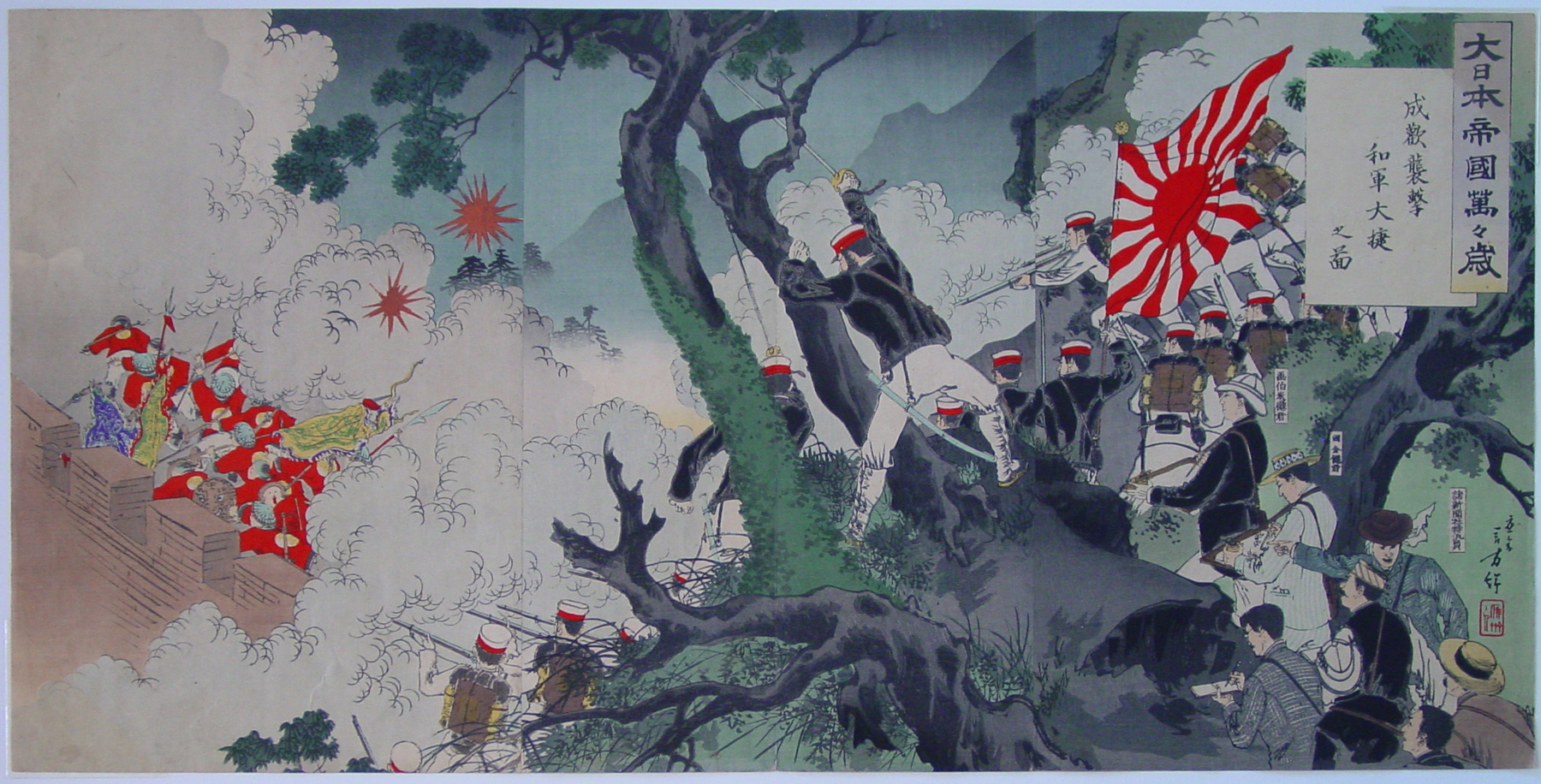About This Print
Battle of Songhwan Observed by Japanese War Correspondents
Source: Impressions of the Front: Woodcuts of the Sino-Japanese War, Shunpei Okamoto, Philadelphia Museum of Art, 1983, p. 20.Eight war correspondents are shown observing the Japanese assault on Chinese troops at Songhwan1 成歓作戦 Korea on July 29, 1894. The foremost reporter in this scene, the white-capped Kubota Beisen (1852-1906), was also a painter, whose observations are recorded in a series of pictorial reports on the Sino-Japanese War. He wrote:
| The company taking the left wing arrived atop the heights northeast of Songhwan at 5:20 AM and, having dug in, started shelling the enemy camp, which was well within range, causing a great deal of damage and a great number of casualties. The infantry also advanced. With a full strike force our men captured five enemy camps by 7:30 AM and the battered Chinese fled, leaving countless quantities of ammunition and supplies, including eight field guns. In these two hours of fierce battle, China suffered five hundred casualties, and Japan, ninety, including two officers. |
1 The Battle of Songhwan (a fort northeast of Asan) is sometimes referred to as the Battle of Asan. Asan, a stronghold south of Seoul, was occupied by the Japanese the next day without a fight.
Source: The Sino-Japanese War, Nathan Chaikin, self-published, 1983, p. 67.
It was the first battle fought by Japan in a foreign war in three hundred years, and it was the first experiment of a new army organized entirely on the European system. Although the Japanese were confident of success, it must have been satisfying to them to find their expectations so fully realized. The Asan campaign was a small affair, but its prompt execution showed that the generals knew how to command, and that the army organization worked smoothly, even in a country without good roads.
Kubota Beisen - Artist and War Correspondent
Source: Japan at the Dawn of the Modern Age – Woodblock Prints from the Meiji Era, Louise E. Virgin, Donald Keene, et. al., MFA Publications, 2001, p. 68.
Source: In Battle's Light: Woodblock Prints of Japan's Early Modern Wars, Elizabeth de Sabato Swinton, Worcester Art Museum, 1991, p. 72.
Followed with interest in newspapers and weekly magazines throughout Japan and the world, the Sino-Japanese War introduced a new occupation to the Japanese - war correspondent. This print documents the new phenomenon and identifies those who accompanied the army in the assault on Songhwan on July 29, 1894, before the formal declaration of war. The figures on the right are simply classified as "newspaper correspondents" (sho-shimbusnsha tokuhain), but those on the left are identified by name - "artist Kinsen" (gahaku Kinsen-kun) and "artist Beisen" (gahaku Beisen-kun). Kubota Beisen (1852-1906), wearing the white pith helmet, was a well-known Kyoto painter. The most important Japanese reporter at the front, he sent eyewitness reports and illustrations that are a primary source of information on the battles. His son Kinsen (1875-1954) was a correspondent during both the Sino-Japanese and Russo-Japanese wars.
Print Details
| IHL Catalog | #89 |
| Title or Description | Ban-Banzai for the Great Japanese Empire! Illustration of the Assault on Songhwan: A Great Victory for Our Troops (Dai Nihon teikoku banbanzai; Seikan shûgeki waga gun taishô no zu 大日本帝国万々歳 成歡襲撃我軍大捷之圖) |
| Artist | Mizuno Toshikata (1866-1908) |
| Signature |  ōju (by request) Toshikata saku ōju (by request) Toshikata saku |
| Seal | Ōsai shujin (per the Museum of Fine Arts, Boston) |
| Publication Date | August 1894 (Meiji 27) |
| Publisher | Akiyama Buemon |
| Impression | excellent |
| Colors | excellent |
| Condition | good - trimmed into image; panels joined; backed; center fold center panel (some separation) |
| Genre | ukiyo-e - senso-e (Sino-Japanese War) |
| Miscellaneous | |
| Format | vertical oban triptych |
| H x W Paper | 13 7/8 x 27 7/8 in. (35.2 x 70.8 cm) |
| Literature | Impressions of the Front: Woodcuts of the Sino-Japanese War, Shunpei Okamoto, Philadelphia Museum of Art, 1983, p. 20. pl. 4; Japan at the Dawn of the Modern Age – WoodblockPrints from the Meiji Era, Louise E. Virgin, Donald Keene, et. al.,MFA Publications, 2001, p. 71, pl. 26; The Sino-JapaneseWar, Nathan Chaikin, self-published, 1983, p. 129, pl. 20; In Battle's Light: Woodblock Prints of Japan's Early Modern Wars, Elizabeth de Sabato Swinton, Worcester Art Museum, 1991, p. 72, pl. 39; Conflicts of Interest: Art and War in Modern Japan, Philip K. Hu, et. al., Saint Louis Museum of Art, 2016, p. 114, pl. 24. |
| Collections This Print | Museum of Fine Arts, Boston RES.27.180a-c and 2000.435a-c; Worcester Art Museum; Saint Louis Museum of Art 338.2010a-c |
3/7/2020


